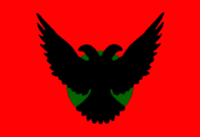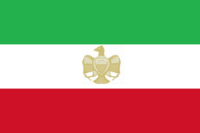أشكالي ومصريو البلقان
| المناطق ذات التجمعات المعتبرة | |
|---|---|
| 26,960[1][أ] | |
| 3,713[2][ب] | |
| 3,368[3][ب] | |
| 2,831[4][5][ت] | |
| 2,054[6][ب] | |
| 172[7] | |
| اللغات | |
| الألبانية | |
| الدين | |
| أغلبية من المسلمين (أساساً Sunni and Bektashi) Orthodox Christian minority[8] | |
أشكالي (Ashkali وأيضاً Aškalije ، Haškalije ، Hashkali) و مصريو البلقان (Jevgs ، Egjiptjant أو Gjupci؛ إنگليزية: Balkan Egyptians) هم أقليات عرقية ثقافية (تجمعات مُعترف بها) تتكلم اللغة الألبانية وتقطن أساساً كوسوڤو. They are sometimes considered to be Albanized Romani, but they do not self-identify as such. Prior to the Kosovo War of 1999, Ashkali registered themselves as Albanians.[9]
During the Kosovo War, they were displaced as refugees in Albania, Serbia and شمال مقدونيا and whole Western Europe such as Germany and France. The "Ashkali" identity was created in 1999, as they tried to show their pro-Albanian stance and distinguish themselves from the Roma (Gypsies).[10]
. . . . . . . . . . . . . . . . . . . . . . . . . . . . . . . . . . . . . . . . . . . . . . . . . . . . . . . . . . . . . . . . . . . . . . . . . . . . . . . . . . . . . . . . . . . . . . . . . . . . . . . . . . . . . . . . . . . . . . . . . . . . . . . . . . . . . . . . . . . . . . . . . . . . . . . . . . . . . . . . . . . . . . . .
التاريخ
تاريخ مصريي البلقان
The origins of the Balkan Egyptians are obscure, but some Balkan historians trace the origin of Balkan Egyptians to the Iron Age, citing vague references in Herodotus of the presence of Khener, an Ancient Egyptian dance group in the region. They also attribute archaeological structures in the area, notably in modern Ohrid and Bitola, as temples of the Goddess Isis, but the Mysteries of Isis was widespread in the Greco-Roman world.[11] It is also possible that the Balkan Egyptians can be traced back to the Doms in Egypt;[12] other versions are that after the Ottoman–Egyptian invasion of Mani, Egyptian soldiers went to Albania.[13] However, historians maintain that during the Ottoman era the Balkan Egyptians and other Balkan Roma were part of a single community that was called by the Ottomans Kıbti (literally 'Copts'), reflecting the same group encompassed by the English ethnonym for the Roma ("Gypsies"). They see the alternate origins as part of a larger phenomenon whereby groups such as the Ashkali and Balkan Egyptians, as part of an effort to achieve greater civil emancipation and to escape anti-Roma prejudice, made an effort to separate themselves from other Roma and constructed a novel history for their peoples.[14]
A 14th-century reference to a placename (Агѹповы клѣти, Agupovy klěti) in the Rila Charter of Ivan Alexander of Bulgaria was thought by some authors, such as Konstantin Josef Jireček, to be related to the Balkan Egyptians, possible descendants of the Doms in Egypt.[15][16]
In 1990, an Egyptian association was formed in Ohrid, from which sprung the Egyptian Liberal Party of North Macedonia, which was attended by representatives from different Balkan countries.[17]
تاريخ الأشكالي
The origin of the Ashkali remains scientifically unexplained. The Ashkali community leaders have constructed a few narratives. According to the Persian narrative, the Ashkali people originated in Persia in the 4th century. According to the Italian narrative, which is based on folk etymology, they are colonists from ancient Rome. According to the Semitic narrative, they originated in Ashkelon (now Israel).[18]
The Ashkali were aligned with Albanians before, during and after the Kosovo war.[9] During the war, many were sent to refugee camps with the Romani people in Kosovo.[9] After the war ended in 1999, some of them reaffirmed their identity as Ashkali to show their pro-Albanian stance and distinguish themselves from the Arlije and Gurbeti Roma, who had been mistakenly viewed as pro-Serbian. However, viewed by the majority population as pro-Serbian Roma, they were persecuted by Albanian nationalists in the presence of NATO forces. As the majority of Kosovo Roma, many of them settled in Serbia and Montenegro. Others moved to Albania, Serbia and Macedonia and the whole of Western Europe, such as Germany and France.[19]
The first Ashkali party (Democratic Ashkali Party of Kosovo) was formed in 2000 under Sabit Rrahmani, who supported Kosovo's independence in the name of all Ashkali.[9]
الديمغرافيا
Most Ashkali and Egyptians live in Kosovo and North Macedonia, but the peoples also reside in Albania, Serbia and Montenegro. In the Macedonian census of 2002, 3,713 people self-identified as "Egyptian". In the Serbian census of 2002 (excluding Kosovo), 814 people self-identified as "Egyptian". In the Montenegrin census, 225 people self-identified as "Egyptian".
Ashkali are predominant in the central and eastern regions of Kosovo: Ferizaj, Kosovo Polje and Lipljan. Egyptians live in western Kosovo: in Gjakova, Istok, Peja and Deçan. The Ashkali/Egyptian community of Kosovo had 98% unemployment in 2009.[20]
الثقافة

Roma, Ashkali, and Egyptians claim ethnic differences among them. Marriages between Egyptians and Albanians are very rare but still more frequent than marriages between Romani and Albanians, while marriages between Egyptians with Roma are extremely rare.
Roma and Ashkalija do not classify one another as Gadje.[20]
The Ashkali and Roma claim the Egyptians as their own; whereas the Ashkali and Egyptians dispute over each other's background.[9] No television or radio channels are dedicated to Askhali or Egyptian minority audiences.[20]
الاضطهاد، حسب منظمة العفو الدولية 2017
PRISTINA (Kosovo), February 22 (SeeNews) - The living situation of Kosovo's Roma, Ashkali and Egyptian communities did not improve last year and they continued to live in overcrowded informal settlements without adequate access to water and other basic services, Amnesty International said.[21]
These communities are suffering institutional dicrimination, in particular in accessing sustainable solutions for housing and employment, as internally displaced persons, the non-governmental organisation said in the 2016/2017 edition of its annual report The State of the World’s Human Rights.
The Human Rights Advisory Panel (HRAP) brought to light past several breaches of the human rights of Roma, Ashkali and Egyptian communities under the mandate of the United Nations Mission in Kosovo (UNMIK), Amnesty International said in its report which covers 159 countries and territories. I
In February 2016 HRAP found out that UNMIK subjected several families from these communities to inhuman and degrading treatment, failed to respect their rights to respect for private and family life and to health and discriminated against them on the grounds of their ethnic background.
In its final report from June 2016, HRAP severely condemned UNMIK for its overall failure to provide accountability for human rights violations, Amnesty International noted.
UNMIK was established in order to provide an interim administration for Kosovo. Its mandate started in June 1999, immediately after the Kosovo war (March 1998 - June 1999). Following the declaration of independence by the Kosovo authorities on 17 February 2008 and the entry into force of the new constitution, the tasks of UNMIK have significantly been modified with its configuration changed and the number of staff reduced.
انظر أيضاً
المراجع
- ^ "Population - by gender ethnicity at settlement level" (PDF). p. 11. Retrieved 31 July 2019.
- ^ Statistički godišnik na Republika Makedonija (in المقدونية). 2007. p. 55. Retrieved 31 July 2019.
- ^ "1.1.13 Popullsia banuese sipas përkatësisë etnike dhe kulturore sipas Përkatësia etnike dhe kulturore, Variabla dhe Viti" (xls). INSTAT - Instituti i Statistikave (in الألبانية). Retrieved 30 July 2019.
- ^ "Попис становништва, домаћинстава и станова 2011. у Републици Србији" (PDF) (in الصربية). Statistics of Serbia. Retrieved 31 July 2019.
- ^ "THIRD REPORT SUBMITTED BY SERBIA PURSUANT TO ARTICLE 25, PARAGRAPH 2 OF THE FRAMEWORK CONVENTION FOR THE PROTECTION OF NATIONAL MINORITIES". Council of Europe. p. 14-15. Retrieved 31 July 2019.
- ^ "STATISTIČKI GODIŠNJAK 2011" (PDF). Statistics of Montenegro: 46. Retrieved 31 July 2019.
{{cite journal}}: Cite journal requires|journal=(help) - ^ "1. POPULATION BY ETHNICITY – DETAILED CLASSIFICATION, 2011 CENSUS". Croatia Bureau of Statistics. 31 January 2012. Retrieved 20 June 2018.
- ^ Nielsen, Jørgen; Akgönül, Samim; Alibašić, Ahmet; Racius, Egdunas, eds. (2013). Yearbook of Muslims in Europe, Volume 5. BRILL. p. 370. ISBN 9789004255869.
- ^ أ ب ت ث ج Valeriu Nicolae; Hannah Slavik (2007). Roma Diplomacy. IDEA. ISBN 978-1-932716-33-7.
- ^ Elsie, Robert (15 November 2010). "Historical Dictionary of Kosovo". Scarecrow Press – via Google Books.
- ^ "Cult Of Isis in Ancient Rome | UNRV.com Roman History". Unrv.com. Retrieved 2022-07-24.
- ^ Zemon, Rubin. "History of the Balkan Egyptians" (PDF).
- ^ "Roma of Albania" (PDF). Center for Documentation and Information on Minorities in Europe - Southeast Europe (CEDIME-SE). Retrieved 9 April 2023.
- ^ Elena Marushiakova; Vesselin Popov, eds. (2021). "Chapetr 1: The Genesis of Roma Emancipation". Roma Voices in History. Brill. pp. 1–32 at 16 & 28. doi:10.30965/9783657705184_002. ISBN 978-3-657-70518-4. S2CID 242216553.
- ^ Даскалова, Ангелина; Мария Райкова (2005). Грамоти на българските царе (in البلغارية). София: Академично издателство "Марин Дринов". p. 57.
- ^ Trubeta, Sevasti (March 2005). "Balkan Egyptians and Gypsy/Roma Discourse" (PDF). Nationalities Papers. 33 (1): 71–95. doi:10.1080/00905990500053788. S2CID 155028453.
- ^ Rubin Zemon. "History of the Balkan Egyptians" (PDF). coe.int. Retrieved 10 March 2024.
- ^ Zemon, Rubin (April 2010). "History of Ashkali identity". In Ailincai, Aurora (ed.). Balkan Egyptians and Ashkali history. Council of Europe – via ResearchGate.
- ^ خطأ استشهاد: وسم
<ref>غير صحيح؛ لا نص تم توفيره للمراجع المسماةLichnofsky - ^ أ ب ت "Notes made from the Ashkali and Egyptian communities for the shadow report on the Implementation of the Framework Convention for the Protection of National Minorities in Kosovo" (PDF). Minelres.lv. Retrieved 15 October 2017.
- ^ أ ب Marina Mikhaylova (2017-02-26). "Roma, Ashkali, Egyptians in Kosovo continue to face bad living conditions - Amnesty Intl". seenews.com.
- ^ "Archived copy". Archived from the original on 2016-01-09. Retrieved 2015-12-26.
{{cite web}}: CS1 maint: archived copy as title (link) - ^ Abedin Toplica: "Flamuri Kombëtar i Ashkalive / Zastava Aškalija / The National Flag", Ashkali Horizonti, nr. 2, 2003 www.ashkali.org.yu "The flag is red with a black rising eagle in front of a green disk. اللونان الأحمر والأسود يشبهان العلم الألباني. القرص الأخضر يمثل الإسلام"
الهامش
| a. | ^ Kosovo is the subject of a territorial dispute between Serbia and the local Albanian majority. The Assembly of Kosovo declared its independence on 17 February 2008, a move that is recognised and the Republic of China (Taiwan), but not by Serbia, which claims it as part of its sovereign territory. |
مراجع مذكورة
- Dragan Novaković, Potomci faraona u Srbiji, DT Magazin, 4. April 1998.
- Marushiakova, Elena; Heuss, Herbert; Boev, Ivan; Rychlik, Jan; Ragaru, Nadege; Zemon, Rubin; Popov, Vesselin; Friedman, Victor (2001). Identity Formation among Minorities in the Balkans: The cases of Roms, Egyptians and Ashkali in Kosovo (PDF). Sofia: Minority Studies Society, Studii Romani.
. . . . . . . . . . . . . . . . . . . . . . . . . . . . . . . . . . . . . . . . . . . . . . . . . . . . . . . . . . . . . . . . . . . . . . . . . . . . . . . . . . . . . . . . . . . . . . . . . . . . . . . . . . . . . . . . . . . . . . . . . . . . . . . . . . . . . . . . . . . . . . . . . . . . . . . . . . . . . . . . . . . . . . . .
وصلات خارجية
- Gypsy Blood: The Roma, Ashkali and Egyptian IDPs of Mitrovica, Kosovo, 2005, https://www.youtube.com/watch?v=1gXxHFTHSz8
- (in Albanian)TV Debate with Ashkali and Egyptian Community Members, ECMI Kosovo (Youtube channel), February 12, 2013, https://www.youtube.com/watch?v=bbzNS20gfWs
- NEW ETHNIC IDENTITIES IN THE BALKANS: THE CASE OF THE EGYPTIANS
- Differences of prejudices and collective blames toward to the Balkan’s Egyptians
- Egjiptianëve Kosovarë
- Union of Balkan's Egyptians
- The New Democratic Initiative of Kosovo (Iniciativa e re Demokrarike e Kosovës)
- New Democratic Initiative of Kosovo, based in Switzerland
- Minority Rights Group
- Ashkali flag at FAME
قالب:Ethnic groups in Kosovo قالب:Ethnic groups of Montenegro
- CS1 المقدونية-language sources (mk)
- CS1 الألبانية-language sources (sq)
- CS1 الصربية-language sources (sr)
- CS1 البلغارية-language sources (bg)
- Articles with hatnote templates targeting a nonexistent page
- Missing redirects
- Articles containing إنگليزية-language text
- Pages using Lang-xx templates
- أشكالي
- Ethnic groups in the Balkans
- Ethnic groups in Kosovo
- Ethnic groups in Albania
- جماعات عرقية في صربيا
- Ethnic groups in Vojvodina
- Muslim communities in Europe

